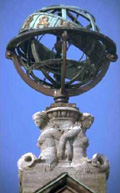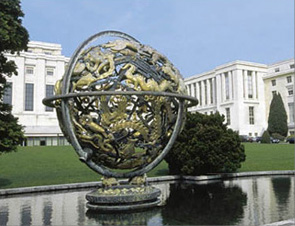Symbolic significance of armillary spheres
 Armillary spheres did not only serve scientific and practical purposes. Many armillary spheres were (and still are) constructed not for use as scientific instruments but to be decorative. For example, an armillary sphere graces the main building of the Hamburg Observatory. Another one crowns the new city hall in Bremen.
Armillary spheres did not only serve scientific and practical purposes. Many armillary spheres were (and still are) constructed not for use as scientific instruments but to be decorative. For example, an armillary sphere graces the main building of the Hamburg Observatory. Another one crowns the new city hall in Bremen. The symbolism of the armillary sphere, suggesting possession of knowledge about the structure of the world and the heavens, was also exploited by important scientists. Some of them had themselves portrayed with an armillary sphere in paintings, engravings and sculptures. This elevated the armillary sphere to the status of an insignia of the sciences.
The symbolism of the armillary sphere, suggesting possession of knowledge about the structure of the world and the heavens, was also exploited by important scientists. Some of them had themselves portrayed with an armillary sphere in paintings, engravings and sculptures. This elevated the armillary sphere to the status of an insignia of the sciences.
Kings, too, used the armillary sphere as a symbol of power. In those days knowledge about the form and structure of the universe meant power. For example, King Manuel I of Portugal (1469-1521) placed an armillary sphere on his coat of arms as an expression of Portuguese might at sea.  This coat of arms still decorates Portugal's national flag.
This coat of arms still decorates Portugal's national flag.
An impressive present-day example is the headquarters of the United Nations in Geneva. An armillary sphere stands in front of the building.  It symbolises the global idea of harmonious co-existence of the nations.
It symbolises the global idea of harmonious co-existence of the nations.
The multi-facetted symbolism of the armillary spheres shows why a great deal of manual and artistic skill always went into their construction. After all, the astronomical information supplied by armillary spheres was available using much simpler means.
We believe that the fascination of these instruments is as great today as it has ever.

